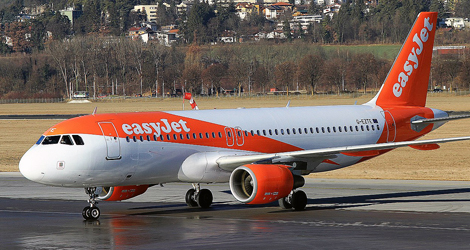EasyJet flight EZY2133 was a scheduled flight from London Luton Airport to Paphos, Cyprus. The forecast weather conditions at Paphos were clear, with a wind from the north-west. After reviewing the flight planning paperwork, the co-pilot was designated as the pilot flying (PF) for the sector. En route, the crew checked the latest weather information for Paphos Airport (elevation 41 ft amsl), which showed that conditions could be suitable for a visual approach to Runway 29. The 1430 hrs Paphos METAR reported: surface wind from 310° at 19 kt, with gusts to 29 kt, visibility more than 10 km, few cumulonimbus clouds at 2,500 ft, few towering cumulus clouds at 3,500 ft and scattered cloud at 5,000 ft, temperature 10°C and QNH 1010 hPa.
The crew of EasyJet EZY2133 planned for both an instrument and a visual approach, to cover the two options.
During the approach briefing, which was conducted before the descent started, the crew of EasyJet flight EZY2133 consulted the Operations Manuals (OM) to review the visual approach procedures. The commander then sketched out a plan of how these procedures would apply to an approach at Paphos in the prevailing conditions.
The approach briefing of EasyJet EZY2133 included a discussion of threat and error management.
A number of potential threats at Paphos were identified, including the effects of the wind on the timing for the downwind leg and the crosswind on final approach. A modification was made to the information on the navigation display, at the co-pilot’s suggestion, with the creation of a 4 nm range ring centred on the Runway 29 threshold. This was to depict the protected area for a circling approach, a technique that the co-pilot of EasyJet flight EZY2133 had been shown on his last simulator check but was not a standard operating procedure (SOP).

EasyJet flight EZY2133
During the descent, the flight crew of EasyJet flight EZY2133 made visual contact with Paphos Airport and requested a visual approach from Paphos ATC. This was approved, with an initial cleared altitude of 4,000 ft amsl. Accordingly, the co-pilot flew a left-hand circuit pattern, joining the downwind leg at that altitude. The TRK/FPA (track/flight path angle) pushbutton was then pressed to select the flight path vector (FPV) (‘the bird’) on the PFD (Primary Flight Display), which also replaced the FD bars with the flight path director (FPD). The airspeed was reduced and Flap 2 was selected. On receiving clearance from ATC, a further descent was initiated to the circuit altitude of 1,500 ft amsl, using the Thrust Idle (THR IDLE) and Open Descent (OP DES) modes, with the autopilot engaged.
Both crew considered that the aircraft was now above the desired profile. The landing gear was selected down and the aircraft passed abeam the Runway 29 threshold at an altitude of 3,500 ft amsl. About 42 seconds later, while still within the 4 nm range ring, the co-pilot of EasyJet flight EZY2133 disconnected the autopilot and started the base turn, with the aircraft descending through an altitude of 3,100 ft amsl at an airspeed of 165 kt.
The associated SOP call ‘autopilot off’ and instruction ‘flight directors off’ were omitted and the FPD remained on.
At the same time, ATC issued revised go-around instructions, advising the aircraft to maintain runway heading and level at an altitude of 2,000 ft amsl, in such an event. This was acknowledged by the commander.
As the aircraft turned onto base leg, the co-pilot announced “speed decaying”. The commander, whose attention was directed outside the aircraft to provide position information during the base turn, thought this was the intention and asked the co-pilot if he required Flap 3. On receiving the latter’s confirmation, Flap 3 was selected.
The aircraft descended through 2,860 ft amsl, with a speed of VLS +5 kt, a high angle of attack and a pitch attitude of 12° nose-up. The speed continued to decay and at VLS -2 kt the FD automatically disengaged.
Concerned about the reduction in airspeed, the co-pilot focused his attention on the airspeed indication. In the turn, the pitch attitude increased and the rate of descent decreased, leading to a further reduction in airspeed.
ALPHA FLOOR then activated and Takeoff/Go-Around (TOGA) thrust was set automatically by the A/THR. The co-pilot announced “alpha floor” and after a few seconds, realising he was losing his situational awareness, handed control to the commander. At that point, the EasyJet flight EZY2133 had a nose-up pitch attitude of 10.5° and was climbing through an altitude of 2,900 ft amsl. The commander, whose attention had been redirected outside the aircraft and had been “startled” by the co-pilot’s announcement, turned the aircraft away from the coastline and terrain, announcing “go-around, flap”.
TOGA thrust was selected on the thrust levers, to match the lever position with thrust, the co-pilot selected Flap 2 and an initial nose-down pitch input was followed by a nose-up pitch input. As the aircraft continued to climb, the Speed Reference System engaged (target speed VAPP) and the FD bars re-appeared.
The speed increased, the flaps were retracted to Flap 1, A/THR was selected off and the thrust levers were moved out of the TOGA detent, to regain control of the thrust. Meanwhile, the landing gear remained down. As the aircraft climbed through 3,900 ft amsl, a TCAS RA “level off, level off” aural alert was triggered. The aircraft was levelled, then descended and passing 3,860 ft amsl the TCAS alert “clear of conflict” was announced.
EasyJet flight EZY2133 continued to descend to 3,380 ft, with the FD remaining on, at which point ATC cleared the aircraft to climb to an altitude of 4,000 ft. Having levelled at 4,000 ft amsl, the autopilot and A/THR were re-engaged.
Thereafter, an uneventful ILS approach and landing on Runway 29 was carried out.
The minimum speed of EasyJet flight EZY2133 recorded during the ALPHA FLOOR event was VLS -7 kt.
Download Report
0 Comments